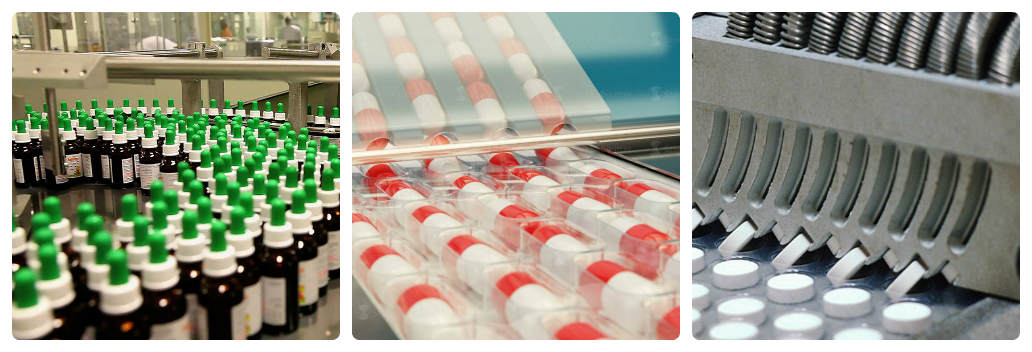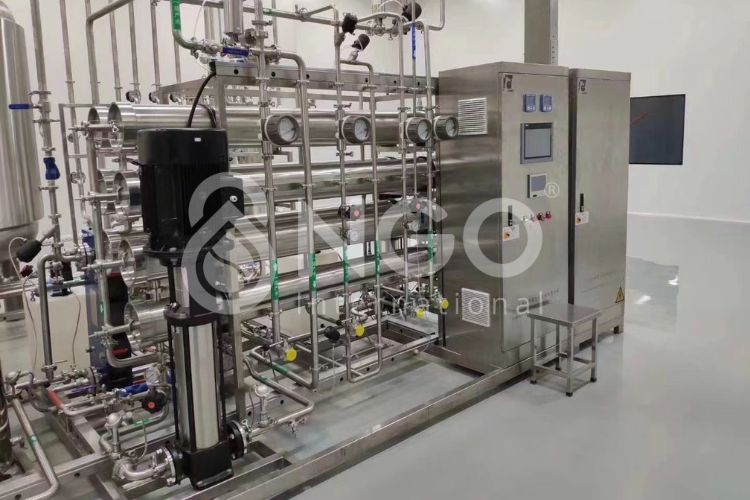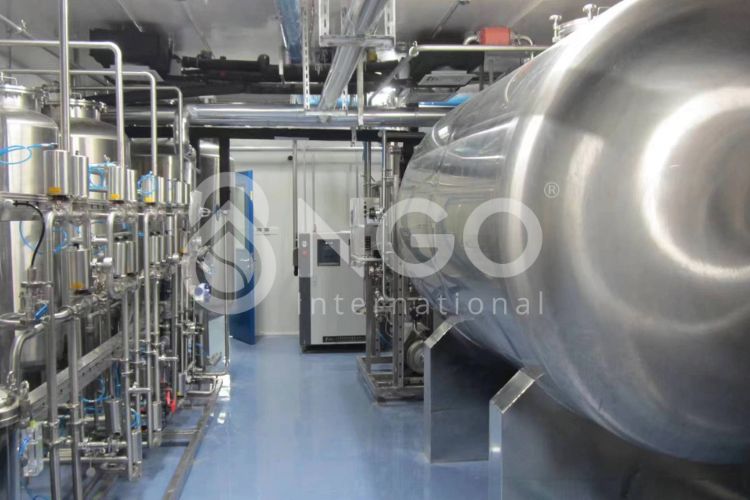PURE WATER SUPPLY FOR PHARMACEUTICAL MANUFACTURERS
In the pharmaceutical industry, purified water is a widely-used raw material in pharmaceutical manufacturing and plays a decisive role for the quality and safety of each product. Therefore, in every pharmaceutical manufacturer, the water treatment system for manufacturing activities must be strictly managed, ensuring simultaneous factors: quality, stable operation.

1. Why do we have to treat water before using it to manufacture pharmaceuticals?
The water used to supply the pharmaceutical industry usually comes from:
• Underground-water
• Water from clean water supply plants in the area
Underground-water sources are often characterized by high amounts of dissolved substances, mainly manganese, calcium, and magnesium, while clean water from water supply plants is not up to the production quality assurance. Therefore, pharmaceutical enterprises are required to treat input water sources to remove impurities or microorganisms that affect the quality of pharmaceuticals.
2. Standard of water supplied for pharmaceutical production activities
Currently, purified water for pharmaceuticals activities in Vietnam is according to GMP standards. Specifically:
|
No. |
PARAMETER |
UNIT |
CONCENTRATION LIMITS |
ACCORDING TO GMP STANDARDS |
|
01 |
PH (25oC) |
U.S |
5.0 – 7.0 |
WHO |
|
02 |
Taste |
0 |
Pharmacopoeia Part III-VN |
|
|
03 |
Calcium and Magnesium |
PPM |
0 |
WHO |
|
04 |
Color temperature |
Pt - Co |
0 |
Pharmacopoeia Part III-VN |
|
05 |
ClorI |
PPM |
0,5 |
WHO |
|
06 |
Sulphate |
PPM |
No change in color after 1 hour |
Determined according to Ph standard Eur (Vo. II) |
|
07 |
Oxidants |
Concentration according to BP standard |
No change in color after 5 minutes |
Ph.Eur |
|
08 |
Ammonium |
PPM |
0.2 |
Ph.Eur |
|
09 |
Nitrate |
PPM |
0.2 |
WHO |
|
10 |
Aluminum |
PPM |
0.01 |
Ph.Eur |
|
11 |
Heavy metal |
PPM |
1 |
Ph.Eur |
|
12 |
Evaporation sludge |
% |
0.001 |
Ph.Eur |
|
13 |
Conductivity |
mS/cm (25oC) |
1.3 (Water for injection) |
WHO |
3. Classification of water used in the pharmaceutical industry:
Normally, the water used in pharmaceutical industry is classified into 04 categories for different uses:
- Domestic water that is municipal tap water, used for dining area, toilets, watering plants outside the production area
- Demineralized water that has undergone soft water treatment, removed some impurities ions in water and some microorganisms, mainly used for boiler water, autoclaves for injections - eye drops, rinsing bottles for eye drops, syringes, machines ...
- Pure water that is used to prepare products that do not require sterility and are free of fever-causing substances
- Distilled water
4. What factors should a pharmaceutical manufacturer consider when investing in a water treatment system?
Currently, the technological process of water treatment for pharmaceutical manufacturing needs to ensure (03) the following factors:
- Water quality
- Easy to operate
- Saving operating costs
In addition, businesses also need to consider a number of other factors:
- Requirements for machinery and equipment: technical assurance, with clear origin
- Analysis, survey of input water before treatment for production
- Careful analysis of the use needs for each stage of pharmaceutical manufacturing, to make appropriate treatment plans
- Consider long-term economic performance, including operation, maintenance, and labour costs
5. Purified water for pharmaceuticals solution provided by NGO:
Technological advantages:
- Concentrated water from the filtration system can be reused, without oxidation risk for the RO filtration stage from oxidizing gases.
- Low-power operation
- Water meets GMP-WHO standard
6. Example of water purification process meeting GMP standard:
Water purification process meets GMP-WHO standard for reference
The treatment process consists of the following main components:
- Multi-material pretreatment system: removes sediment and suspended particles in water, and absorbs free chlorine, to prevent oxidation of free chlorine while avoiding damage to RO membrane at Post-processing step. The material can also adsorb heavy metals, small organic molecules. After this step, the turbidity in the water is controlled at SDI ≤ 5.
- 2-stage RO filter system: The reverse osmosis device has the advantages of compact structure, small area, high production volume and low energy consumption. Reverse osmosis equipment is the most important desalination equipment in this process, including safety filter, phase I pump, phase I RO system, phase II pump, phase II RO system. It also help eliminate bacteria, virus and heat source.
- Demineralization: Urban water contains sodium, calcium, magnesium, chloride, nitrate, bicarbonate, silica and other soluble salts. These salts include anions and cations. More than 99% of ions can be removed by appropriate reverse osmosis (RO). Municipal water also contains trace metals, dissolved gases (such as CO2) and other weak ionic compounds that must be removed in industrial applications (such as boron and silica).
- The conductivity of water after the RO filtration step (the input water of the EDI demineraliser) is usually between 4 and 20 us / cm, ie the reaction rate is 50-250 kΩ.cm; and according to different application fields, the resistance of pure or deionized water is usually from 2-18.2 MΩ. Demineralization process is to remove unwanted ions through hydroxyl ion exchange or hydroxide ions.
- Cleaning chemical system: including chemical containers, dosage adjustment equipment, agitator for routine RO cleaning.
- Automatic control system
Some pictures of project:



If your business is interested in solution to purified water in pharmaceutical manufacturing, or has a demand for ion exchange materials, please contact NGO via phone number (024) 3566 8225 or email office@8ngo.com for direct consultation.
-
 Wastewater treatment
Wastewater treatment
-
 A standard domestic wastewater
A standard domestic wastewater
-
 B standard domestic wastewater
B standard domestic wastewater
-
 Pig Farm Wastewater
Pig Farm Wastewater
-
 Textile dyeing wastewater
Textile dyeing wastewater
-
 Paper industry wastewater solution
Paper industry wastewater solution
-
 Textile Dyeing Wastewater & Industrial Washing
Textile Dyeing Wastewater & Industrial Washing
-
 Slaughter wastewater treatment solution
Slaughter wastewater treatment solution
-
 Aquaculture wastewater
Aquaculture wastewater
-
 Starch wastewater
Starch wastewater
-
 Petroleum wastewater
Petroleum wastewater
-
 Beer wastewater
Beer wastewater
-
 Other industrial wastewaters
Other industrial wastewaters
-
 BioPM - Organic Industrial wastewater treatment solution
BioPM - Organic Industrial wastewater treatment solution
-
 MBR solutions
MBR solutions
-
 Conventional activated sludge (CAS)
Conventional activated sludge (CAS)
-
 Moving bed biofilm reactor (MBBR)
Moving bed biofilm reactor (MBBR)
-
 Anaerobic- Anoxic-Aerobic (AAO)
Anaerobic- Anoxic-Aerobic (AAO)
-
 Sequencing batch reactor (SBR)
Sequencing batch reactor (SBR)
-
 Physical & Chemical methods
Physical & Chemical methods
-
 Supply water treatment
Supply water treatment
-
 Cooling system water
Cooling system water
-
 Water treatment for food and Beverage production
Water treatment for food and Beverage production
-
 Ultra pure water supply solution for electronic industry
Ultra pure water supply solution for electronic industry
-
 Pure water supply for pharmaceutical manufacturers
Pure water supply for pharmaceutical manufacturers
-
 Water Supply treatment with ion exchange method
Water Supply treatment with ion exchange method
-
 Ordor Treatment
Ordor Treatment


